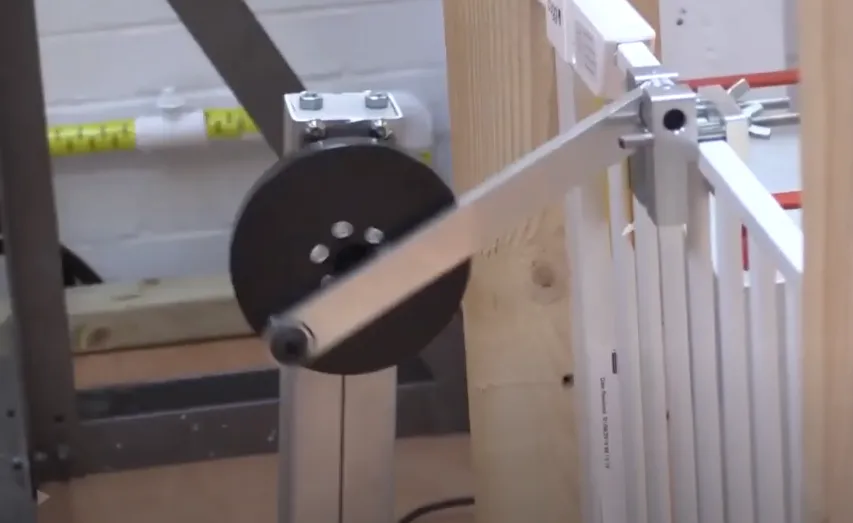UNE EN 716 Cribs Safety Requirements and Testing
The UNE EN 716 standard defines the safety requirements and testing methods applicable to cribs intended for children up to three years of age. This regulation is crucial in ensuring that cribs meet strict safety standards, protecting young children from potential hazards such as suffocation, entrapment, or other risks associated with unsafe sleeping environments.
The standard covers various aspects including the crib structure itself, mattress dimensions and stability, side rails, headboards, footboards, and the overall design of the crib. Compliance with these requirements is essential for manufacturers aiming to meet international safety standards and avoid recalls or product withdrawals due to non-compliance.
UNE EN 716 specifies detailed test procedures that must be followed to ensure compliance. These tests include structural integrity checks, mattress stability assessments, side rail strength evaluations, and many other critical safety measures. Manufacturers need to have a robust quality assurance process in place to consistently meet these stringent requirements.
The testing process involves several steps, starting with the preparation of test specimens according to specified dimensions and conditions. The crib is then subjected to various mechanical tests designed to simulate real-world use scenarios, such as static load tests on side rails and mattress stability checks under different weight distributions.
Another key aspect of UNE EN 716 is the requirement for regular inspections and audits by independent third-party laboratories. These labs ensure that cribs are produced consistently and meet all safety requirements without deviation. The use of advanced testing equipment, such as load testers and dimensional scanners, adds precision to these evaluations.
The standard also emphasizes the importance of proper documentation and traceability throughout the manufacturing process. This includes detailed records of material sourcing, manufacturing processes, and quality control checks at various stages of production. Such practices enhance transparency and accountability in meeting safety standards.
Compliance with UNE EN 716 is not just a legal requirement but also an investment in brand reputation and consumer trust. By adhering to these stringent safety requirements, manufacturers can ensure their products are safe for use by young children. This commitment to quality helps build long-term relationships with customers who value safety and reliability.
In conclusion, the UNE EN 716 standard plays a vital role in safeguarding children's health and well-being by setting clear guidelines on crib design, construction, and testing procedures. For manufacturers and suppliers, adhering to this standard ensures compliance with international regulations while enhancing product quality and customer satisfaction.
Quality and Reliability Assurance
Quality assurance (QA) is fundamental in ensuring that products meet the highest standards of safety and reliability. In the context of UNE EN 716 cribs, QA processes encompass multiple stages from raw material selection to final product inspection.
The first step involves stringent quality control at every stage of production. This includes rigorous checks on incoming materials to ensure they comply with specified specifications regarding strength, durability, and finish quality. For example, wood used in crib construction must meet specific hardness and moisture content criteria outlined by the standard.
Manufacturers also invest heavily in advanced manufacturing techniques that enhance both performance and safety features. Automated CNC machines are often employed for precise cutting and shaping of components, reducing human error and ensuring consistent product quality. Similarly, robotic welding systems provide high precision for joining metal parts securely.
To maintain consistency across batches, continuous monitoring is conducted throughout the production line using state-of-the-art sensors and cameras. These tools help detect any deviations from set parameters early on, allowing immediate corrective actions to be taken before defects become significant issues.
Regular audits by independent third-party laboratories further reinforce QA efforts. These experts conduct comprehensive assessments based on strict criteria defined in UNE EN 716. They perform detailed inspections of both completed cribs and raw materials, checking for compliance with all relevant requirements. Their reports provide valuable insights into areas where improvements can be made.
In addition to these internal measures, companies also engage external certification bodies periodically for formal audits and validations. These certifications serve as independent endorsements confirming that products adhere strictly to UNE EN 716 standards. They offer added credibility to brands seeking to establish themselves as leaders in safe childcare solutions.
By implementing robust QA practices, manufacturers demonstrate a strong commitment to producing reliable cribs that meet the highest safety benchmarks set forth by international regulations like UNE EN 716. This dedication not only protects children but also builds trust among consumers who value quality and reliability above all else.
Customer Impact and Satisfaction
The impact of adhering to UNE EN 716 cribs safety requirements extends far beyond regulatory compliance; it profoundly influences customer satisfaction and brand loyalty. Customers today are increasingly concerned about the safety of products they purchase, especially when it comes to items intended for young children.
By ensuring that their cribs meet or exceed these stringent standards, manufacturers can significantly boost consumer confidence. Parents feel reassured knowing that their choice aligns with internationally recognized guidelines designed specifically for child safety. This trust fosters positive customer experiences and enhances overall satisfaction levels.
Maintaining high standards also allows companies to differentiate themselves in a competitive market. In an era where quality and reliability are paramount, demonstrating adherence to such rigorous specifications sets brands apart as leaders within the industry. Potential buyers are more likely to choose products from reputable sources that prioritize safety above all else.
The long-term benefits of maintaining these standards include reduced risk of recalls or legal actions against non-compliant items. Companies that consistently meet regulatory requirements face lower insurance premiums and fewer disruptions in supply chains due to potential issues arising from faulty goods. These savings translate into improved profitability, allowing businesses to reinvest resources back into innovation and expansion.
Moreover, satisfied customers often become loyal advocates for the brand through positive word-of-mouth referrals and repeat purchases. This口碑和满意度的影响深远,不仅在于提升品牌形象,还体现在长期的市场竞争力上。坚持高标准不仅能增强消费者的信任感,还能帮助企业在激烈的市场竞争中脱颖而出。潜在买家更倾向于选择那些以安全为首要考量的品牌。 此外,遵守这些严格标准的企业还可以享受到更低的保险费用以及由于不合格产品引起的供应链中断风险降低的好处。这些节省下来的资源可以重新投入到创新和扩展业务之中。长期来看,这有助于提高盈利能力,并进一步推动企业的增长和发展。 总之,坚持执行UNE EN 716标准不仅满足了法律法规的要求,也为消费者提供了安全保障,同时提升了品牌的信誉度和市场竞争力。





